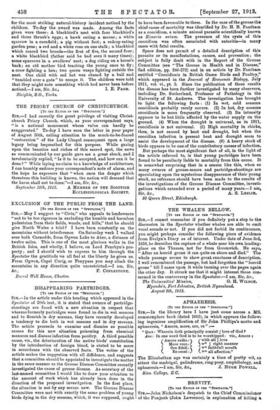DISAPPEARING PARTRIDGES.
[To TILE EDITOR OP THE "SFECTATOR."]
SIR,—In the article under this beading which appeared in the Spectator of 20th inst., it is stated that owners of partridge- shootings are faced with a new situation in respect that whereas formerly partridges were found to die in wet seasons and to flourish in dry seasons, they have recently developed a tendency to die both in wet seasons and in dry seasons. The article proceeds to examine and dismiss as possible causes for this new situation poisoning from chemical manures and disease infection from poultry. A third possible cause, viz., the deterioration of the native birds' constitution by the introduction of foreign blood, is stated to be more in accordance with the observed facts. The writer of the article makes the suggestion with all diffidence, and suggests that a committee should be appointed to investigate the matter in the same manner as the Grouse Disease Committee recently investigated the cause of grouse disease. As secretary of the last-named committee I would like to draw your attention to the amount of work which has already been done in the direction of the proposed investigation. In the first place, the situation is not by any means new. The Grouse Disease Committee were met with exactly the same problem of young birds dying in the dry seasons, which, it was supposed, ought
to have been favourable to them. In the case of the grouse tho chief cause of mortality was identified by Dr. H. B. Fantham as a coccidium, a minute animal parasite scientifically known as _Eimeria avium. The presence of the cysts of this coccidium was often associated with enteritis—in many cases with fatal results.
Space does not permit of a detailed description of this parasite or its manifestations, causes, and prevention ; the subject is fully dealt with in the Report of the Grouse Committee (see "The Grouse in Health and in Disease," 2nd edition, pp. 246-272) and in an article by Dr. Fantham entitled " Coccidiosis in British Game Birds and Poultry," which appeared in the Journal of Economic Biology, July' 1911, vol. vi., pt. 3. Since the publication of these results the disease has been further investigated by many observers, including Dr. Sutherland, Professor of Pathology in the University of St. Andrews. The investigation has brought to light the following facts : (1) In wet, cold seasons coccidiosis probably rarely occurs. (2) In hot, dry seasons coccidiosis is more frequently observed. (3) Its intensity appears to be but little affected by the water supply on the ground. (4) When the drought is universal, as in 1911, coccidiosis is not universal. (5) High mortality in chicks, then, is not caused by heat and drought, but when the coccidian infection is present heat and drought seem to assist the development of the disease. (6) A heavy stock of birds appears to be one of the contributory causes of infection.
But perhaps the most significant fact of all, in the light of the article referred to, is that young partridges have been found to be peculiarly liable to mortality from this cause. It is somewhat surprising that in a season like this, when so many owners of grouse-moors and partridge-shootings are speculating upon the mysterious disappearance of their young stock, no reference should have been made to the results of the investigations of the Grouse Disease Committee, investi- gations which extended over a period of many years.—I am,










































 Previous page
Previous page